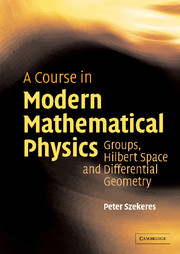Book contents
- Frontmatter
- Contents
- Preface
- Acknowledgements
- Dedication
- 1 Sets and structures
- 2 Groups
- 3 Vector spaces
- 4 Linear operators and matrices
- 5 Inner product spaces
- 6 Algebras
- 7 Tensors
- 8 Exterior algebra
- 9 Special relativity
- 10 Topology
- 11 Measure theory and integration
- 12 Distributions
- 13 Hilbert spaces
- 14 Quantum mechanics
- 15 Differential geometry
- 16 Differentiable forms
- 17 Integration on manifolds
- 18 Connections and curvature
- 19 Lie groups and Lie algebras
- Bibliography
- Index
3 - Vector spaces
Published online by Cambridge University Press: 05 September 2012
- Frontmatter
- Contents
- Preface
- Acknowledgements
- Dedication
- 1 Sets and structures
- 2 Groups
- 3 Vector spaces
- 4 Linear operators and matrices
- 5 Inner product spaces
- 6 Algebras
- 7 Tensors
- 8 Exterior algebra
- 9 Special relativity
- 10 Topology
- 11 Measure theory and integration
- 12 Distributions
- 13 Hilbert spaces
- 14 Quantum mechanics
- 15 Differential geometry
- 16 Differentiable forms
- 17 Integration on manifolds
- 18 Connections and curvature
- 19 Lie groups and Lie algebras
- Bibliography
- Index
Summary
Some algebraic structures have more than one law of composition. These must be connected by some kind of distributive laws, else the separate laws of composition are simply independent structures on the same set. The most elementary algebraic structures of this kind are known as rings and fields, and by combining fields and abelian groups we create vector spaces [1–7].
For the rest of this book, vector spaces will never be far away. For example, Hilbert spaces are structured vector spaces that form the basis of quantum mechanics. Even in non-linear theories such as classical mechanics and general relativity there exist local vector spaces known as the tangent space at each point, which are needed to formulate the dynamical equations. It is hard to think of a branch of physics that does not use vector spaces in some aspect of its formulation.
Rings and fields
A ringR is a set with two laws of composition called addition and multiplication, denoted a + b and ab respectively. It is required that R is an abelian group with respect to +, with identity element 0 and inverses denoted −a. With respect to multiplication R is to be a commutative semigroup, so that the identity and inverses are not necessarily present. In detail, the requirements of a ring are:
(R1) Addition is associative, (a + b) + c = a + (b + c).
(R2) Addition is commutative, a + b = b + a.
(R3) There is an element 0 such that a + 0 = a for all a ∈ R.
- Type
- Chapter
- Information
- A Course in Modern Mathematical PhysicsGroups, Hilbert Space and Differential Geometry, pp. 59 - 97Publisher: Cambridge University PressPrint publication year: 2004



